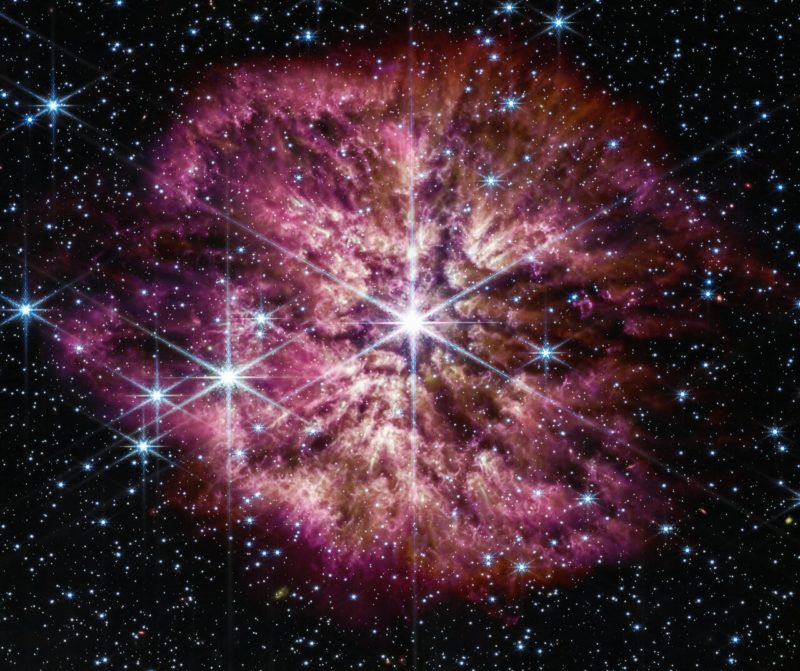
In the vast cosmos, where the stars illuminate the darkness, lies a celestial mystery: the star Wolf-Rayet. What is a Wolf-Rayet star and why does it amaze astronomers?
Unraveling the enigma of these cosmic giants is a journey into the interior of the heart of stellar wonders, exploring their discovery, their unique characteristics and the fundamental role they play in shaping the cosmos. Join us as we unravel the secrets of the Wolf-Rayet stars, shedding light on the celestial wonders that continue to challenge our understanding of the universe.
What is a Wolf-Rayet star?
A Wolf-Rayet star is a massive, hot, luminous stellar giant characterized by intense stellar winds, strong emission lines in its spectrum, and a higher surface temperature than almost all other types of stars. These enigmatic stars play a crucial role in the evolution of massive stars, enriching the interstellar medium with heavy elements through their powerful stellar winds before finally culminating in a supernova explosion.
Discovery of Wolf-Rayet stars
The discovery of the Wolf-Rayet stars in the 19th century by astronomers Charles Wolf and Georges Rayet represents an important milestone in the annals of astronomy. In 1867, his systematic observations revealed a group of stars that displayed distinctive spectral features, particularly strong emission lines.
Eduardo Carlos Pickering, a prominent astronomer of the late 19th century, played a crucial role in deciphering the nature of Wolf-Rayet stars. He theorized that the mysterious emission bands in their spectra were related to an unusual state of hydrogen. The subsequent identification of the “Pickering series” revealed a pattern similar to the Balmer series, finally establishing that these lines resulted from the presence of helium. Pickering's ideas also established connections between Wolf-Rayet spectra and nebular spectra, suggesting that some or all of the Wolf-Rayet stars acted as central stars of planetary nebulae.
These peculiar features prompted the recognition of a new class of massive stars, later designated Wolf-Rayet stars in honor of their discoverers. Wolf and Rayet's meticulous work laid the foundation for a deeper understanding of these luminous entities, marking a crucial advance in our understanding of stellar astrophysics.
The discovery raised fundamental questions about the unique spectral signatures these stars exhibit. This prompted further research into the underlying astrophysical processes governing Wolf-Rayet stars and their role in the broader context of stellar evolution. Since then, the historical narrative of its identification has guided ongoing research, shaping our knowledge of the intricate cosmic tapestry of the universe.
Characteristics of Wolf-Rayet stars
Wolf-Rayet stars exhibit a distinctive set of characteristics that define them as celestial powers. These enormous luminaires attract attention due to their extraordinary characteristics.
Temperature range
These stars have surface temperatures that range between 20,000K to around 210,000K, ranking among the hottest in the cosmos. This intense heat plays a key role in shaping their unique spectral characteristics, making them a fascinating subject of study in astrophysics.
Mass and size compared to the sun
In the cosmic hierarchy, Wolf-Rayet stars reign as giants. Their masses, which range between 10 to 200 solar massesand their substantial sizes dwarf our Sun, making them colossal entities that play a vital role in shaping their cosmic environment.
Strong emission lines in their spectra
The spectra of Wolf-Rayet stars are characterized by broad, strong emission lines, a defining feature that baffled astronomers for years. Unraveling this mystery led to the identification of highly ionized elements, shedding light on the Intricate chemistry within these celestial giants.
Intense stellar winds and mass loss
Wolf-Rayet stars are not just cosmic luminaries; They are also cosmic sculptors. The intense stellar winds, driven by its extreme temperatures, cause significant mass loss. This phenomenon enriches the surrounding interstellar medium with heavy elements, contributing to the complex cycle of stellar evolution.
Wolf-Rayet stars and nebulae
The relationship between Wolf-Rayet stars and nebulae is profound. These stars are often found at the hearts of nebulae and their intense stellar winds play a crucial role in shaping and illuminating these cosmic clouds of gas and dust. The interaction results in the creation of intricate structures and contributes to the enrichment of the interstellar medium.
Evolution of Wolf-Rayet stars
The life cycle of Wolf-Rayet stars unfolds as a captivating cosmic saga. This phase in the existence of massive stars involves a series of intricate transformations that chart their evolutionary journey through the cosmos.
Transition to the Wolf-Rayet phase
The journey toward becoming a Wolf-Rayet star is marked by a transition from previous stellar phases. As massive stars exhaust their nuclear fuel, they undergo profound changes that ultimately lead them to the Wolf-Rayet phase. This transition is a fundamental chapter in its evolution.
Role in the life cycle of massive stars
Wolf-Rayet stars play a vital role in the intricate web of massive stellar evolution. Their formation and subsequent stellar winds contribute to the enrichment of the interstellar medium with heavy elements, influencing the conditions for the future formation of stars and planetary systems.
Relationship to supernova explosions
The Wolf-Rayet phase culminates in a spectacular stellar event: a supernova explosion. This explosive ending marks the final chapter in the lives of these massive stars, dispersing elements across the cosmos and contributing to the dynamic processes that shape galaxies.
Conclusion
In short, the exploration of what a Wolf-Rayet star is has illuminated the cosmos with the brilliance of these celestial giants. From their discovery by Charles Wolf and Georges Rayet to their role as stellar architects that shape nebulae, Wolf-Rayet stars are enigmatic luminaries that leave an indelible mark on our understanding of the universe. As we delve into their characteristics and complexities, these stars emerge not only as astronomical phenomena but as cosmic storytellers, weaving narratives of transformation and enrichment across the vast cosmic canvas.













Leave feedback about this